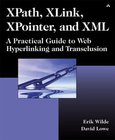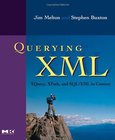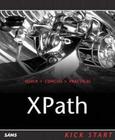Xpath and Xpointer
Locating Content in XML Documents

Book Details:
| Publisher: | O'Reilly Media |
| Series: | OReilly |
| Author: | John E. Simpson |
| Edition: | 1 |
| ISBN-10: | 0596002912 |
| ISBN-13: | 9780596002916 |
| Pages: | 210 |
| Published: | Aug 07 2002 |
| Posted: | Nov 19 2014 |
| Language: | English |
| Book format: | |
| Book size: | 2.69 MB |
Book Description:
Referring to specific information inside an XML document is a little like finding a needle in a haystack: how do you differentiate the information you need from everything else? XPath and XPointer are two closely related languages that play a key role in XML processing by allowing developers to find these needles and manipulate embedded information. XPath describes a route for finding specific items by defining a path through the hierarchy of an XML document, abstracting only the information that's relevant for identifying the data. XPointer extends XPath to identify more complex parts of documents. The two technologies are critical for developers seeking needles in haystacks in various types of processing.XPath and XPointer fills an essential need for XML developers by focusing directly on a critical topic that has been covered only briefly. Written by John Simpson, an author with considerable XML experience, the book offers practical knowledge of the two languages that underpin XML, XSLT and XLink. XPath and XPointer cuts through basic theory and provides real-world examples that you can use right away.Written for XML and XSLT developers and anyone else who needs to address information in XML documents, the book assumes a working knowledge of XML and XSLT. It begins with an introduction to XPath basics. You'll learn about location steps and paths, XPath functions and numeric operators. Once you've covered XPath in depth, you'll move on to XPointer--its background, syntax, and forms of addressing. By the time you've finished the book, you'll know how to construct a full XPointer (one that uses an XPath location path to address document content) and completely understand both the XPath and XPointer features it uses.XPath and XPointer contains material on the forthcoming XPath 2.0 spec and EXSLT extensions, as well as versions 1.0 of both XPath and XPointer. A succinct but thorough hands-on guide, no other book on the market provides comprehensive information on these two key XML technologies in one place.
Book categories:
Programming , Software , Web Development , Programming Languages , XML , XPath , XPointerDownload Link:
Related Books:
XPath XLink XPointer and XML
A Practical Guide to Web Hyperlinking and Transclusion
Although the Web has grown continuously since its introduction in the early 90's, its technical foundations have remained relatively stable. However, the introduction of XML, along with a sequence of related technologies such as XPath, XLink, and XPointer, has heralded a substantial change in the way in which content can be managed. The most significant of these changes is with respect to the hypermedia functionality which is enabled by the new technologies of XLink and XPointer, especially richer linking and navigation models. This book will describe the new hypermedia features of the XLink/XPointer-enabled Web for developers who are interested in how these new concepts can be used for Web publishing. This book will offer its readers an overview of ...
Querying XML
XQuery, XPath, and SQL/XML in context
XML has become the lingua franca for representing business data, for exchanging information between business partners and applications, and for adding structure-and sometimes meaning-to text-based documents. XML offers some special challenges and opportunities in the area of search: querying XML can produce very precise, fine-grained results, if you know how to express and execute those queries.For software developers and systems architects: this book teaches the most useful approaches to querying XML documents and repositories. This book will also help managers and project leaders grasp how "querying XML fits into the larger context of querying and XML. Querying XML provides a comprehensive background from fundamental concepts (What is XML?) to...
XPath Kick Start
Navigating XML with XPath 1.0 and 2.0
XPath is to XML as SQL is to databases: XML applications need XPath to locate specific data within an XML document for further processing with other XML applications such as XSLT, XQuery, XPointer, XLink and DOM level 3. With XPath, these applications offer developers a full toolkit for transforming, linking, and searching XML data. Developers need to understand XPath to fully exploit XML in their applications, and they have few resources beyond the W3C specification. XPath Kick Start will examine every aspect of XPath in detail, including its influence on and use with these other XML standards. With each technique illustrated with real-world examples, the book starts with coverage of the essentials of XPath, including nodes, expressions, functions a...
2007 - 2021 © eBooks-IT.org



